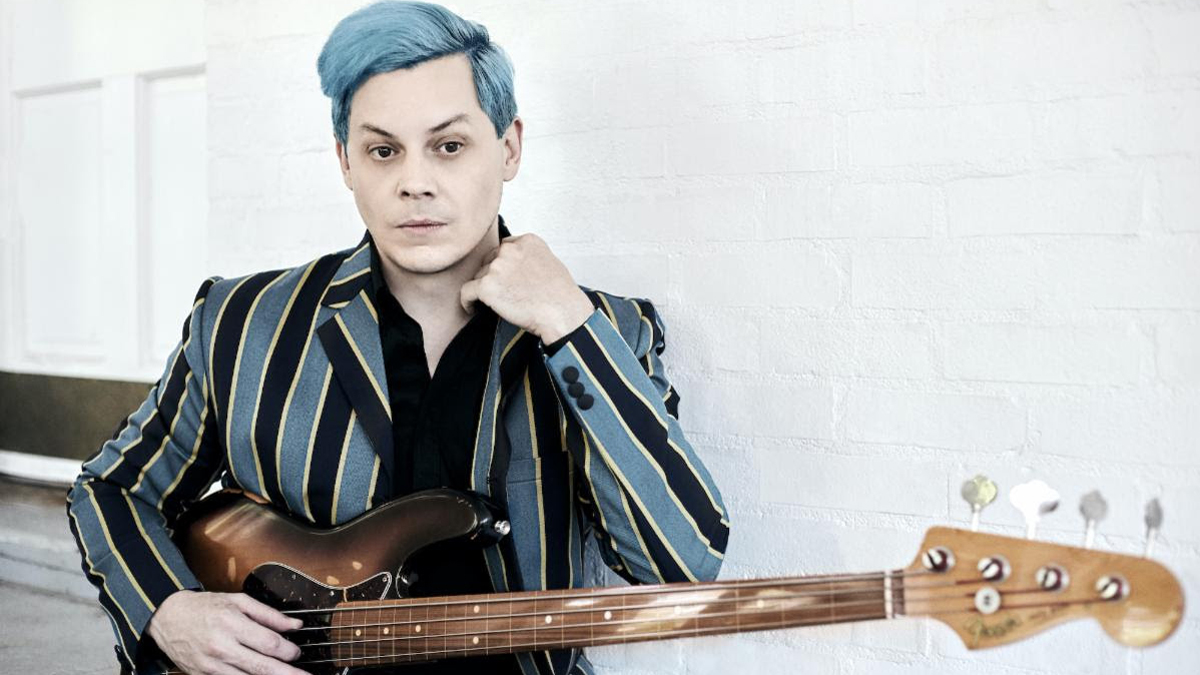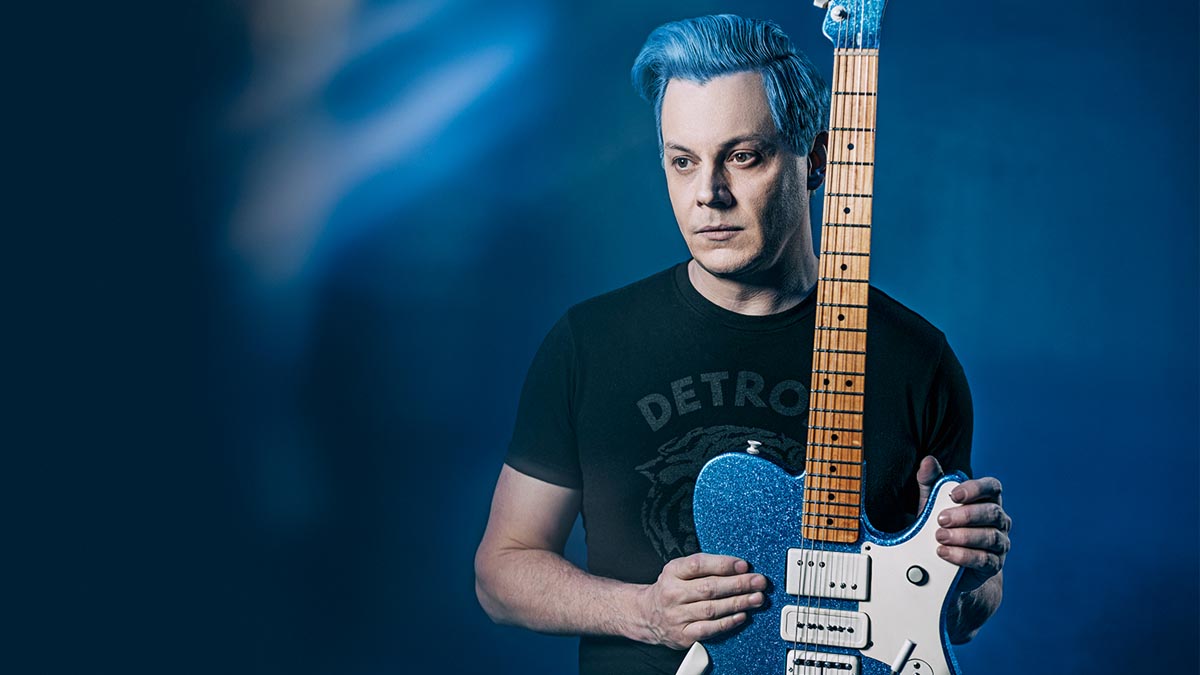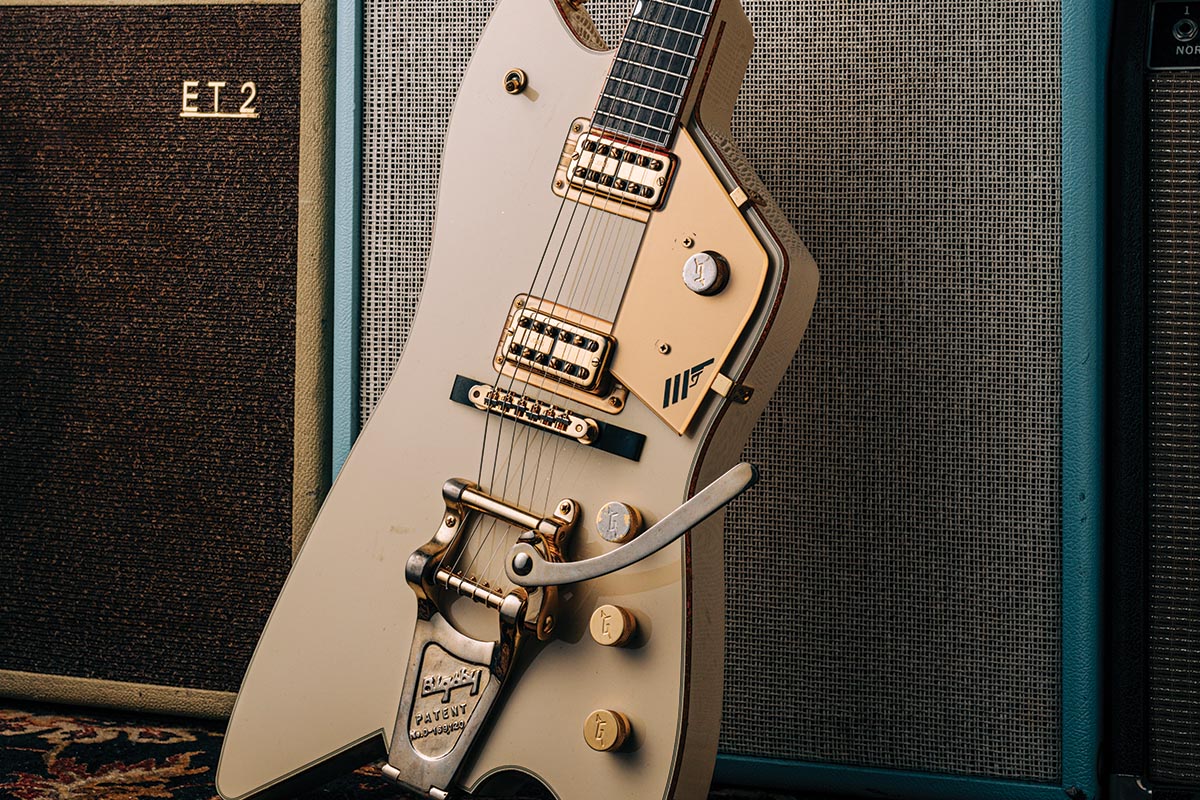The many faces of Jack White: the innovator, visionary and gearhead’s story so far
Jack White is a guitar hero like no other. Here we profile his gear choices, his stylistic curveballs, and find a player whose restless creative vigor drives him on

In the heyday of the guitar hero, the 1960s and 70s, you could hardly move for them. Guitars were the dominant instrument in popular culture and those who could conjure riffs were gods among mortals.
But while great new electric guitar players turn up daily, guitar heroes – names bordering on the mythical, who take over the mainstream and whose names become synonymous with awesome licks – come along less often. In the 21st Century, the one who stands tallest is Jack White.
One man who graduated from guitar hero to guitar god is Jeff Beck. When Beck invited The White Stripes to join him on stage at his 2002 Royal Festival Hall residency, it suggested a passing of the torch. Beck, who many call the greatest living guitarist, spotted White’s genius.
The White Stripes were then known only as one of the ‘The’ bands, disparate garage rock revivalists who all happened to hit success in 2001. Other leading figures in the moment were The Hives, The Strokes and The Vines.
‘The’ bands represented a punk rock reaction against nu metal, much as grunge was to hair metal ten years earlier. At a time when metal albums were overproduced into oblivion, every element digitally shifted to be metronomically in time, garage rock was a refreshing celebration of the lo-fi, the loose, and the lairy.
Strange as it seems now, it was initially unclear which of the ‘The’ bands would be the movement’s Beatles and which its Herman’s Hermits. Unclear to all except perhaps Jeff Beck, who saw the spark.
Jack White is a genuine polymath - guitarist, writer, arranger, producer, gear aficionado and creator of a mini-empire in Third Man Records. Here, TG profiles an extraordinary career: The Many Faces Of Jack White...
Get The Pick Newsletter
All the latest guitar news, interviews, lessons, reviews, deals and more, direct to your inbox!
The Trailblazer
When The White Stripes’ self-titled debut album was released in 1999, back when Jack was still married to drummer Meg White, some critics dismissed the duo format as a gimmick. But the lack of a bassist served Jack and Meg’s vision.
Being a duo made them agile. They could deliver tempo changes and cue hits with eye contact that is hard to orchestrate with bigger ensembles.
White's guitar tone could be anything he wanted without worrying about blending with the bass
It also gave Jack unlimited sonic space. His note choices when soloing were unconstrained by the need to harmonise with anyone else, and his guitar tone could be anything he wanted without worrying about blending with the bass.
You might expect that meant a huge, bass-heavy tone, but White opted for a snotty, obnoxious sound, especially on the early records. Detroit garage rock forebears The MC5 and The Stooges were an obvious point of comparison, but the rough production on White Stripes albums also recalled early blues.
The ratty sound quality recalled tapes by Alan Lomax, the musicologist who made field recordings of pioneers like Lead Belly and Muddy Waters. Those unaccompanied blues performances often changed tempo and rhythm unexpectedly, a quality the bassless White duo could easily imitate.
Now, thanks in large part to The White Stripes’ success, rock duos no longer seem unlikely. Royal Blood are the most obvious beneficiaries of the Stripes’ blazed trail, but MGMT, The Kills, and a host of less famous pairings also followed in their wake.

The Guitar Hero
Guitar heroes are not only great guitarists. You can tell this by thinking about who qualifies as one. Keith Richards, Slash, and Jimi Hendrix are guitar heroes; YouTube shredders, your guitar teacher, and Andrés Segovia are not. White is effortlessly believable as a rock star.
Admittedly he’d never trash a hotel room – he’s expressed too much sympathy for the workers who clean them – but that just makes him seem more in tune with the people. Joe Bonamassa has become famous playing the guitar, but he remains, by his own admission, unabashedly nerdy.
White, like Prince or David Bowie, is enigmatic enough that if you learned he’d been born in another solar system, you’d only be briefly surprised.
The White Stripes’ position as just one ‘The’ band among many changed with their major label debut Elephant. Its unstoppable first single Seven Nation Army is undoubtedly the biggest riff of the 21st Century.
And as recognisable as even Smoke On The Water thanks to its adoption on football terraces, Seven Nation Army gave The White Stripes a hit that everybody’s parents know. If Jack White was his generation’s Kurt Cobain, Seven Nation Army was his Smells Like Teen Spirit.
Elephant included a ton of solos, marking the arrival of Jack White the guitar hero. Guitar magazines were slow to hail White’s lead playing because it wasn’t technical, but it was the kind of playing that made people excited about the guitar. That year Rolling Stone magazine ranked him the 17th greatest guitarist of all time, which looked premature at the time and prescient now.
As Kurt had on Teen Spirit, White made an epic track even bigger by sticking close to the melody for the solo in Seven Nation Army. The lead break in There’s No Home For You Here opened with a Hendrix-worthy burst of sustained feedback, before Jack’s chaotic DigiTech Whammy abuse began. The notes were almost all pentatonic, but the frenzied pitch shifting made it sound totally unconventional.
While specialist blues magazines lamented declining audiences and a lack of new mainstream stars, The White Stripes dedicated albums to blues pioneers Son House and Blind Willie McTell. Elephant had Ball And Biscuit, a pure blues song hiding in plain sight on a number one album.
That song and Black Math made prominent use of Jack’s ‘stutter’ technique, perhaps his biggest playing innovation. It sounded like a rapidly executed killswitch, but there was no killswitch on his Airline guitar, and live performances saw him creating the effect standing away from his pedalboard.
It stumped many guitarists, and YouTube still features several incorrect explanations of how it’s done. White was bouncing his picking hand off the string.
The flesh of his index finger caught the string as the pick came down, choking it, and then the pick brushed the string as he bounced off, sounding the note. His fuzz pedal exaggerated the staccato effect by acting like a noise gate.
The Stripes’ burgeoning popularity gave global audiences the chance to see White live, where he truly excelled. His spontaneous freakouts, powered by the same nervous energy that drives his frenetic vibrato, were at their best when feeding off an audience.
His habit of kicking the Whammy pedal in and out mid-lick could make even blues clichés sound like nothing anyone had heard. Elephant had seen White begin to embrace octave effects to fill out the bass frequencies, and his Whammy-equipped tone sounded monstrous at festivals across the world.
Live, the Seven Nation Army solo could become a wild affair, riotously over-sliding for the high notes while keeping the general shape of the melody. This reckless abandon would have sounded disastrous with a bassist, but unaccompanied it just worked.
Their showmanship made The White Stripes memorable TV guests, too. On their Later... With Jools Holland debut, Jack snapped his fifth string. Where other acts would have gone for another take, Jack coolly retuned mid solo and finished the song.
While performing Let’s Build A Home on Tonight With Conan O’Brien, White left the stage to slam his Crestwood Astral onto O’Brien’s desk, using it as a lap steel and pummeling the guitar with stuttering pyrotechnics.
After a detour for the more piano-driven Get Behind Me Satan, in 2007 The White Stripes rocked hard on their final album Icky Thump, a celebration of guitar. While the title track wasn’t as eminently chantable as Seven Nation Army, for our money it’s an even better riff.
His mixture of palm muting and slide for the riffs on Catch Hell Blues again showed his knack for making well-worn ideas sound new with his unique approach. Touring, however, became increasingly unmanageable due to Meg’s anxiety, and by 2011 the duo would confirm they were calling it quits.

The Team Player
Even as The White Stripes exploded, White found time to start another band. The Raconteurs debuted in 2006 showing that White could fit discretely into a five-piece band (if you count touring keyboardist Dean Fertita) just as well as he could dominate proceedings.
The psychedelic and power-pop stylings of The Raconteurs were far more conventionally radio-friendly than The White Stripes, but White’s experience as an improviser was still key to proceedings.
As co-frontman Brendan Benson would later put it, “With the Raconteurs it’s like, ‘how far can we go with not playing the song?’” Live, album closer Blue Veins became a titanic blues epic, with the band dropping out for parts of White’s extended solo.
But guitar extravaganzas were not The Raconteurs’ principal game. Their tightly crafted pop tunes showed that White could serve the song just as well as explode it.
This was further confirmed when White formed The Dead Weather with The Kills’ Alison Mosshart, Queens Of The Stone Age guitarist Dean Fertita, and Raconteurs bandmate Jack Lawrence on bass.
White played drums, giving Mosshart and Fertita the intimidating job of playing guitar in front of their generation’s biggest guitar hero. Fertita, though, insisted it was “an easy relationship”, adding, “I might want to go on and on doing takes, but having another guitar player there to say ‘that was a cool one’ makes my job a lot easier... He never suggests what I play or insists on anything.”
As The White Stripes ended, White spread his talents into multiple genres. He produced and played on Loretta Lynn’s 2004 release Van Lear Rose, helping make the country legend’s first album in over a decade the most successful of her career. Jack’s understated slide licks showed he could deliver pure roots music without pedalboard gimmicks.
Later, Jack duetted with Alicia Keys on Another Way To Die from Quantum Of Solace, supplying the filthiest guitar ever heard in James Bond theme. Panned at the time as a poor choice for Bond, it remains terminally underrated in its own right. Its existence, though, was a reminder that you call White for big riffs just as surely as you know who to call when there’s something strange in ya neighbourhood.
When Beyoncé wanted a rock song in 2016, she summoned White to co-write and co-produce. This collaboration might have been a 21st century Beat It, but disappointingly White elected to put barely any guitar on it.
It was nevertheless nominated for a Grammy for Best Rock Performance, although apart from the drums sampled from Zeppelin’s When The Levee Breaks, there’s not much rock about it.
But this again showed White as a musician, not merely a guitarist. Piling on his guitar might have boosted his ego, but in the current musical climate, it wouldn’t have been what the song needed. It did, however, have a hook that could have been a monster guitar riff, as his solo performances of the song have shown.
The Gearhead

While the enigmatic White would never write “Welcome to Nerdville” above the entrance to his studio, his gear choices betray a geekiness that is every inch the equal of Joe Bonamassa’s. But where Bonamassa’s collection is all the most elite boutique gear, White has a love of junk shop finds.
In a review of Icky Thump, Rolling Stone critic Robert Christgau quipped that Jack had “hauled new detritus into his theoretical garage.” But the garage was anything but theoretical, and Jack’s new sounds have often come from unloved old gear, which he would, as he put it, fight to get them to sound good.
Jack’s love of stuttering sounds has found him discovering numerous ways to produce them. For the Raconteurs’ first tour he kept a killswitch pedal on top of his amp which he operated with his picking hand at crucial moments. On recordings, he experimented with adding tremolo effects or even splicing in silences to finished takes to create the desired effect.
He was ahead of the curve in adopting phase-locked loop (PLL) synth-fuzz pedals. Already popular with synth users, phase-locked loops are oscillators that maintain a relationship between the input and the output, so although the noises are chaotic and glitchy, they are harmonious.
White’s adoption of the Mantic Flex monophonic PLL for his solo on Why Walk A Dog? brought them to the attention of guitarists as a bold new sound. While many listeners assumed the diving pitch sounds were produced by a Whammy, they actually came from the Flex.

There were signs, however, that White has become less interested in fighting his gear over time. In 2018 he picked up an EVH Wolfgang after reading that Eddie had designed a guitar that would not fight him at all.
And he named his favourite guitar amp as the 15” speaker version of the Fender Vibroverb, noting that players with great tone like Stevie Ray Vaughan and Duane Eddy had used them. His Raconteurs guitar rig expanded to include custom shop Gibsons and Fenders, a sign perhaps that White was ready for guitars that co-operate with his efforts at making music.
The recording of the Raconteurs’ 2019 album Help Us Stranger gives a few clues to White’s continuing greatness. He continued to innovate, constructing (with help from Fender’s custom shop) the Three-Wheel-Motion Low Rider Telecaster.
This hot-rod inspired affair had a strap-operated B-bender, plus lever-operated Hipshot G- and E-benders, plus a switch for Drop D inspired by the EVH D-tuna. For pickups, it included a single coil bridge, P90 middle, and a neck wide-range humbucker pinched from an old Tele Thinline.
Sunday Driver saw him recording for the first time with a classic setup he had long avoided: a Gibson Les Paul into a Fender Champ
A momentary killswitch, also inspired by EVH, made his stuttering effects more accessible. He continued to champion PLL sounds, most obviously on Sunday Driver. This was White the inventor, always in search of new sounds.
On the other hand, the album also saw him recording for the first time with a classic setup he had long avoided: a Gibson Les Paul into a Fender Champ. This was White the realist, choosing the sound that worked for the songs, even if it killed his contrarian impulses to use such a conventional rig.
With CopperSound pedals, White has recently developed the Triplegraph polyphonic octave pedal. This beast of a pedal can produce upper and lower octaves via either momentary or latching modes, and boasts (what else?) a momentary killswitch mode for effortless stuttering.
But by distributing these pedals, as well as the Mantic Flex, through his own Third Man company, White has shown a commitment to making unique sounds accessible, rather than keeping them all to himself.
The Record Man
Jack registered the Third Man name back in 2001, but he didn’t do anything with the label until 2008, when The White Stripes stopped recording and he acquired the rights to their back catalogue. With Third Man Records, White is a self-appointed keeper of the flame of American roots music.
He’s reissued classics by Blind Willie McTell and The Supremes, and released the entire recorded works of 1930s guitar-and-fiddle group The Mississippi Sheiks.
He’s also financed new music by legends: as well as the aforementioned Loretta Lynn, White produced and released rockabilly queen Wanda Jackson’s comeback. He’s also nurtured young artists careers, making him the curator of a collection of great music.
Third Man has one of only three vinyl pressing plants in the US, and its rolling record store, a converted bus, made its debut at SXSW in 2011. There are now Third Man venues in London, Nashville, and Detroit, making the beginnings of an analogue empire.
The Torch Holder
White’s reputation as a guitarist was cemented for many by his selection as the new kid, alongside legends Jimmy Page and The Edge, for 2009 documentary It Might Get Loud. That selection of players reflected differences between musicians and non-musicians about what makes a great guitarist.
While Page was an obvious choice, guitar magazine readers would probably have voted for Eddie Van Halen to represent the 80s, and perhaps Matt Bellamy or Mark Tremonti for the present day. White, however, instantly won over audiences by playing slide on a one-string diddly bow he hastily built from a plank!
Later in the film, his solo rendition of I Fought Piranhas showed a guitarist as steeped in the history of the instrument as he was invested in moving it forward. He clearly worshipped the blues, but he was interested in performing it as he felt it should be today, not being a historic re-enactor. In that sense, he was the natural heir to Page – a view cemented in the public imagination by Page’s endorsement.
The Page similarities don’t end there. While both are most famous as guitarists, they are arguably even more talented as producers, arrangers, songwriters, and band leaders.
Both have a vision of how they want music to be, and a mastery of every aspect of the process to bring that vision into reality. Both are crafters of earth-shattering riffs. And both have technical limitations as guitarists, but their histrionic delivery has a power more refined players can’t touch.
It Might Get Loud also hinted at White’s solo future. Fly Farm Blues, knocked out in 10 minutes during the making of the documentary, became his first solo single. Sounding like a John Lee Hooker song played back through a fuzz pedal, it was a moment of garage-blues inspiration.
In October 2020, the producers of Saturday Night Live found themselves with an unexpected vacancy for a musical guest. Coincidentally, Eddie Van Halen had died the same week, and SNL wanted a guitar hero.
Jack White got the call, appearing with his blue EVH Wolfgang and throwing in a tapping lick at the end of Lazaretto. Jack, for his part, modestly wrote on Instagram: “I won’t even insult the man’s talent by trying to play one of his songs.”
- Fear of the Dawn is out now via Third Man Records.
Jenna writes for Total Guitar and Guitar World, and is the former classic rock columnist for Guitar Techniques. She studied with Guthrie Govan at BIMM, and has taught guitar for 15 years. She's toured in 10 countries and played on a Top 10 album (in Sweden).
“His songs are timeless, you can’t tell if they were written in the 1400s or now”: Michael Hurley, guitarist and singer/songwriter known as the ‘Godfather of freak folk,’ dies at 83
“The future is pretty bright”: Norman's Rare Guitars has unearthed another future blues great – and the 15-year-old guitar star has already jammed with Michael Lemmo










